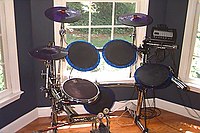
Photo from wikipedia
Textile electronics embedded in clothing represent an exciting new frontier for modern healthcare and communication systems. Fundamental to the development of these textile electronics is the development of the fibers… Click to show full abstract
Textile electronics embedded in clothing represent an exciting new frontier for modern healthcare and communication systems. Fundamental to the development of these textile electronics is the development of the fibers forming the cloths into electronic devices. An electronic fiber must undergo diverse scrutiny for its selection for a multifunctional textile, viz., from the material selection to the device architecture, from the wearability to mechanical stresses, and from the environmental compatibility to the end‐use management. Herein, the performance requirements of fiber‐shaped electronics are reviewed considering the characteristics of single electronic fibers and their assemblies in smart clothing. Broadly, this article includes i) processing strategies of electronic fibers with required properties from precursor to material, ii) the state‐of‐art of current fiber‐shaped electronics emphasizing light‐emitting devices, solar cells, sensors, nanogenerators, supercapacitors storage, and chromatic devices, iii) mechanisms involved in the operation of the above devices, iv) limitations of the current materials and device manufacturing techniques to achieve the target performance, and v) the knowledge gap that must be minimized prior to their deployment. Lessons learned from this review with regard to the challenges and prospects for developing fiber‐shaped electronic components are presented as directions for future research on wearable electronics.
Journal Title: Advanced Energy Materials
Year Published: 2021
Link to full text (if available)
Share on Social Media: Sign Up to like & get
recommendations!